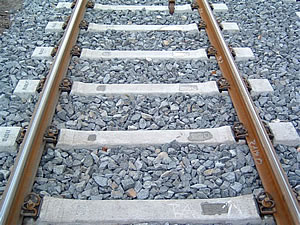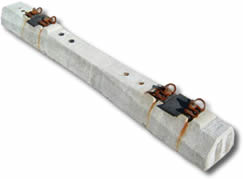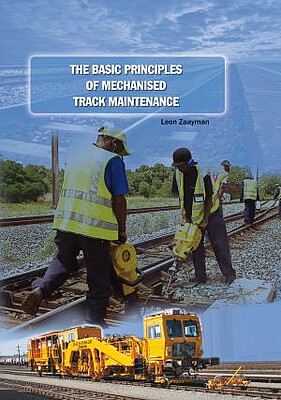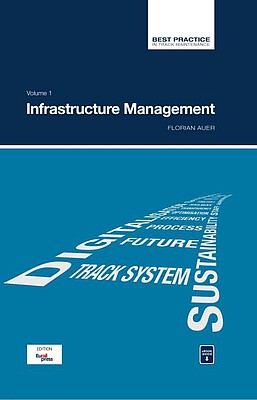Concrete sleepers / ties
Since wooden sleepers are made from an expensive raw material, experiments were conducted to see what other materials were suitable for the substructure of the track. A search was made for a building material that was easy to bring to a suitable shape. Concrete was found to be such a material.
Due to the ease with which fresh concrete can be processed it offers a number of design possibilities.
The first concrete sleepers were introduced around 1890.
Production of concrete sleepers:
A reinforcement is placed in the sleeper so that it can withstand the tensile forces (which lead to crack formation). With the early stripping of the concrete from the mould elongated cavities are inserted in the sleeper, so that later the steel reinforcement bars can be fed into them and clamped. After the casting and hardening of the sleeper, the bonding takes place.
The bonding of concrete at a higher temperature occurs faster, and generates a chemical, exothermic process. By supplying steam (heat) the bonding is sped up, in order to achieve the required strength quicker.
In winter when it is extremely cold heat has to be supplied to the concrete from outside. The pre-stressing rods are introduced into the channels. The tractive force is applied and then the cavity between the steel and the concrete is filled with cement sludge.
In the late stripping process the formwork is used as a tensioning bed for the reinforcement. For prestressing in direct bonding, the prestressing reinforcement is tensioned before concreting (against the formwork) and then enveloped in the tensioned state by fresh concrete. The concrete remains in the formwork (late stripping) until it is cured.
The concrete sleeper is first cast for the preload and then must be bonded in order to achieve the compressive strength. This is called concrete production with subsequent bonding. Subsequently, the stressing steel is threaded in and prestressed against the concrete.
The compressive strength after the completion of the sleeper should be 60 N/mm². After about a day the new concrete sleeper has reached its outer form, but the final strength of the concrete takes approximately 28 days to develop and therefore much longer.
Benefits:
- resistant to animal and vegetable parasites
- restoring with plastic dowels is feasible
- high weight, thereby improving geometrical security
- good gauge retention
- low price
- long service life
Disadvantages:
- heavy weight when installing
- if there is a derailment there is severe damage to the sleeper and a replacement will be necessary
- no repair if there is cracking
You can find suitable specialist literature to the topic here:
The Basic Principles of Mechanised Track Maintenance
This book is dedicated to the many people involved in the day to day planning and performance of track maintenance activities. Providing a practical approach to everyday challenges in mechanised track maintenance, it is not just intended as a theoretical approach to the track system.
Railways aim at transporting people and freight safely, rapidly, regularly, comfortably and on time from one place to another. This book is directed to track infrastructure departments contributing to the above objective by ensuring the track infrastructure’s reliability, availability, maintainability and safety – denoted by the acronym RAMS. Regular, effective and affordable track maintenance enable RAMS to be achieved.
Best Practice in Track Maintenance, Vol 1 - Infrastructure Management
Infrastructure Management Volume 1 looks at aspects of infrastructure management with particular reference to the single European railway area. Based on best-practice examples from Central Europe, measures for the targeted retrofitting and improvement of the infrastructure maintenance of the existing network are presented. In many cases, infrastructure operators are faced with a generational change, which accelerates the process. Modern information and communication technology can simplify the comprehension and presentation of complex contexts. Modified approaches to asset management and life-cycle management enable implementation of the "transparent permanent way" or the "railway 4.0".




